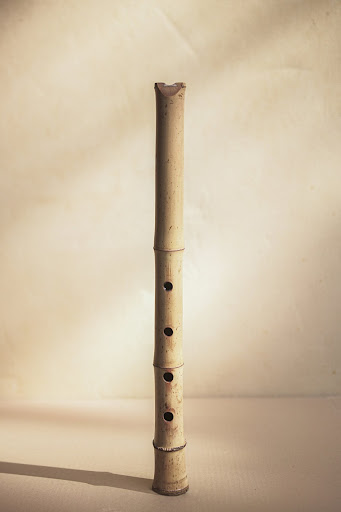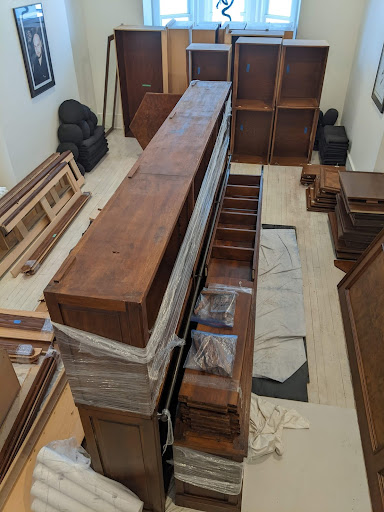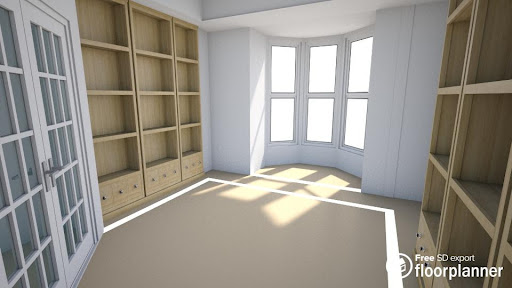
Shakuhachi
eMirror Vol 26, No. 12

Shakuhachi
eMirror Vol 26, No. 12
Friday, March 18th
Edited by the Practice Council
The White Wind Zen Community:
An international community practising and teaching Dogen’s Zen since 1985.
The only instrument other than my voice and the various instruments such as the umpan, gong, drum, mokugyo and so on that are all used in the environment of our formal practice that I play is the shakuhachi. This traditional Japanese instrument derives from Chinese forebears but differs considerably. A shakuhachi is an end-blown flute.
Unlike a Western side-blown flute or an instrument such as a clarinet, it has no mechanism to blow through. The instrument’s shape and the placement of the holes are all that it has. It is a piece of bamboo, lacquered on the inside with four holes in the front and one in the back. Its blowing edge, called an utaguchi is usually a piece of shell. Generally one does not throw pebbles against it. Instead, the breath is moved over and under the edge of the utagachi and moves through the hollow bore. The angle with which it is held against the chin, the posture of the body, the depth and consistency of the breath, the subtlety of the fingering, the temperature and moisture of the air, and the gradual buildup of humidity within the bore give rise to how this note will sound. In fact, this is how the two octaves of Otsu and Ro are played, by angling the chin, and the variation of force of the breath.
Each time a classical honkyoku piece is played it is always different. To play it you must be willing to be informed by how each note presents itself through the dynamic intimacy of breath, bamboo, posture, rainfall or lack of it and so on. And you must be willing to make a mistake. And perhaps to incorporate a mistake as it happens into the body of the playing such that the following notes are lifted by it. Of course that means you have to notice the mistake as it happens and, instead of closing down or backing away, move with it to align it.
The honkyoku compositions are primarily exercises of posture and breath and hearing, not intended for performance before an audience but simply to be played. Through my experience of this instrument, I prefer that any performance that I hear will take into account unknowability or the Sky of how this note will sound; the Ground of technique; and the Being of an alive presentation.
What all of this means is that I believe that listening to and composing and performing music can clarify how we hear the sounds that move within the space of hearing and that rise and fall within the Awareness which we all are.
-Ven Anzan Hoshin roshi, continuing Class Three: The Sea of Sounds" in the series "Zen Arts: The Flowering of the Senses", October 1999 Daruma-ki O-sesshin, Dainen-ji.
Fusatsu: March 30th, April 13th and 27th.
Keizan Ki
March 21st is the memorial for Keizan Jokin zenji.
Hanamatsuri Two-day Sesshin
The Hanamatsuri two-day session will begin at 8:00 p.m. on Friday, April 8th, and will end at 6:00 p.m. on Sunday, April 10th.
Hermitage
The Roshi is currently in an extended period of "self-isolation" due to underlying health issues until the COVID-19 situation clarifies.
Beginning Instruction in Zen Practice
For information concerning our Long-distance Training Program, please visit this Web Page: https://wwzc.org/long-distance-training-program
Rev. Chiso anagarika sat her weekly semi-retreat on Tuesday, March 15th at her home in the Berkshires.
If you would like to sit a retreat at home please follow the schedule outlined in this page: https://wwzc.org/retreat-schedule-public-students. After your retreat, please send an email to schedule@wwzc.org to confirm that you sat a retreat and include the duration and location.
Work has recently begun on converting the empty east wing rooms at Dainen-ji. The first part of the project is to build the Shuryo (a monastery Library and Study Hall) in the main section of the space. As you will have read about previously in the eMirror, Saigyo ino travelled to Toronto recently to dismantle and bring back a large second-hand oak and burled walnut library, which will be built into the new space.
As the dismantled library is currently being housed in the Zendo (one of our two practice rooms), it is a priority to get this room completed so that the Zendo is functional again for when the monastery opens to students and to the public.

Dismantled library currently in the Zendo
Saigyo ino has made arrangements to take two months of unpaid leave from his work to do the majority of the construction and, with as much help as possible from students, hopes to complete the work by May.
Although a great deal of money will be saved by having the Ino and students work on this project, funds are still required for the purchase of materials and to pay an electrician for the electrical work needed. If you are able to donate towards this project your help will be very much appreciated. All donations will be tax deductible. And if you would like to assist with the work, please contact the Ino at saigyo dot cross at wwzc dot org to discuss your schedule.
Thank you very much.
Here are a couple of renderings by the Ino which gives an idea of what the Shuryo will look like when completed.


Saturday, March 19th to Saturday, March 26th
Saturday, March 19th: "Drawn In, Moving Forth": Zen Master Anzan Hoshin's Commentaries on Eihei Dogen zenji's “Bendowa: A Talk on Exerting the Way”: "Fire" (25 of 28)
Sunday, March 20th: SAkN ”Root Cycle Three” by Ven. Anzan Hoshin roshi: “The Spectrum of Radiance” (teisho 8 of 8)
Monday, March 21st: “Every Breath You Take” by Ven. Shikai Zuiko o-sensei: “Seeing People Who Suffer" (Dharma Talk 81)
Thursday, March 24th: “Opening Traps and Cages” by Ven. Jinmyo Renge sensei
Saturday, March 26th: "Drawn In, Moving Forth": Zen Master Anzan Hoshin's Commentaries on Eihei Dogen zenji's “Bendowa: A Talk on Exerting the Way”: "Stories of Stones and Stars" (26 of 28)
Associate and general students should continue to follow the recorded Teachings schedule for the sitting you were attending at the monastery, and listen to that during your home practice.
You can access the online Recorded Teachings Library at wwzc.org/recorded-teachings-schedule.
You can also use the streaming site at app.wwzc.org to live stream recordings from the online Library. If you have forgotten your password or need assistance with accessing the recorded Teachings, please email schedule@wwzc.org.
Please note that teisho should be listened to in the correct order and with none missed out as themes, metaphors, questions raised and answered evolve in spirals throughout the series.
While most of the online Recorded Teachings library is password-protected and only accessible to students of the Lineage of Zen Master Anzan Hoshin, a small selection of MP3 recordings of teisho are accessible to the public at wwzc.org/recorded-teachings Additional recordings will be uploaded periodically. MP3 recordings of four recorded teisho by Ven. Anzan Hoshin roshi are currently available:
Dharma Position https://wwzc.org/dharma-position
Eyes See, Ears Hear https://wwzc.org/eyes-see-ears-hear
Embarrassment https://wwzc.org/embarrassment
Ven. Anzan Hoshin roshi's reading of his translation of Eihei Dogen zenji's “Bendowa: A Talk on Exerting the Way”: https://wwzc.org/bendowa-talk-exerting-way

Photograph of Ven. Anzan Hoshin roshi at Daijozan, mid-1980s,
by Ven. Shikai Zuiko sensei
Ven. Anzan Hoshin roshi has recently completed translation work on some shorter texts by Eihei Dogen zenji from the Shobogenzo. The work on these particular texts is based upon the literal translations that he worked on with Joshu Dainen roshi at Hakukaze-ji around 1977-78 followed by many years of putting them down, picking them up, and polishing. Naturally, more essential texts such as Uji, Genjokoan, Shinjin Gakudo and some 40 others were completed first and have been given extensive commentaries by the Roshi. This batch of texts includes Baike: Plum Blossoms, Ryugin: Howling Dragon, and Udonge: The Udumbara Blossoming and many others are nearing completion. Annotation details and successfully conveying them across various document formats are the issue at this point.
Work on Bussho: Buddha Nature, a very long and nuanced text by Dogen zenji, is ongoing.
Roshi is also finishing an update to the Saijo Shingi: The Deportment of Radiance, our manual of monastic training standards which is a supplement to the ancient Eihei Shingi and Keizan Shingi.
Begun by Ven. Shikai Zuiko o-sensei
Finished by Rev. Fushin Comeau shramon following her death

Continuing on with “Painted Cakes: A Zen Dictionary,” a limited edition text written by Anzan Hoshin roshi in the 1980s and last revised in 1994.
Sutra (S); Sutta (P); Kyo or Gyo (J); Ching ( C)
A "thread" of discourse. A record of Buddhist teachings.
Posted March 18th, 2022. New entries are posted every two weeks.

Dogen zenji taught in the Tenzo kyokun: Instructions for the Tenzo (https://wwzc.org/dharma-text/tenzo-kyokun-instructions-tenzo) that the work of preparing and serving meals is "a matter for realized monks who have the mind of the Way or by senior disciples who have roused the Way-seeking mind." In alignment with this, part of Zen Master Anzan Hoshin's samu for the Community involves personally overseeing the activities of the ancient office of tenzo. Ven. Jinmyo Renge sensei serves as tenzo and Mishin godo and Saigyo ino offer assistance as tenzo-anja. The following meals were prepared for residents on Monday, Tuesday and Thursday evenings.
Monday Yakuseki:
Biryani (Basmati rice, caramelised onion, sauteed diced carrots and potato, lentils, chopped poblano and red bell peppers, turmeric, cumin, coriander, cayenne pepper, and some zafrani masala made by Jinmyo sensei); butternut squash soup (butternut squash, white onion, celery, madras curry powder, a little cream); tomato and cucumber salad dressed with yogurt mixed with finely chopped lime pickle, mango, black pepper and cumin.
Tuesday Yakuseki:
Hot crusty rolls with butter; vegetarian option: a thick white bean stew (kidney beans, chopped potatoes, chopped Spanish onion, celery, diced carrots, minced garlic, corn and baby green peas, dried porcini mushrooms, vegetable stock, thyme, basil, oregano, Dijon mustard, apple cider vinegar; for those who wished to supplement their diet with meat, the above white kidney bean stew with added sauteed chicken thigh meat. Salad of Romaine lettuce, red leaf lettuce, radicchio, radishes, thinly sliced red onion, chopped tomatoes, chopped celery, served with a salad dressing made with equal parts mayonnaise, Dijon mustard, apple cider vinegar, with added honey and black pepper.
Thursday Yakuseki:
Fettuccine with garlic/butter sauce, parmesan cheese and cream; chopped gailan and dai gai choy with strips of poblano, onion, and red bell peppers, cooked with red kidney beans, seasoned with red balsamic vinegar, garlic, and lots of black pepper; pickle of cubed Friulano with sweet gherkins and lemon zest.
.jpg)
If you would like to thank someone for a contribution they have made, please feel free to send an email to Jinmyo osho at rengezo at Gmail dot com, but be sure to type "eMirror" in the subject line.
From Robin Whitehead:
Thank you to Saigyo ino for providing me with very helpful information about incense to assist me to locate quality incense for my home practice.
From the Office of the Treasurer:
Thank you to Bruce O'Roak for a donation towards construction of the new Shuryo (monastic library and study hall).
|